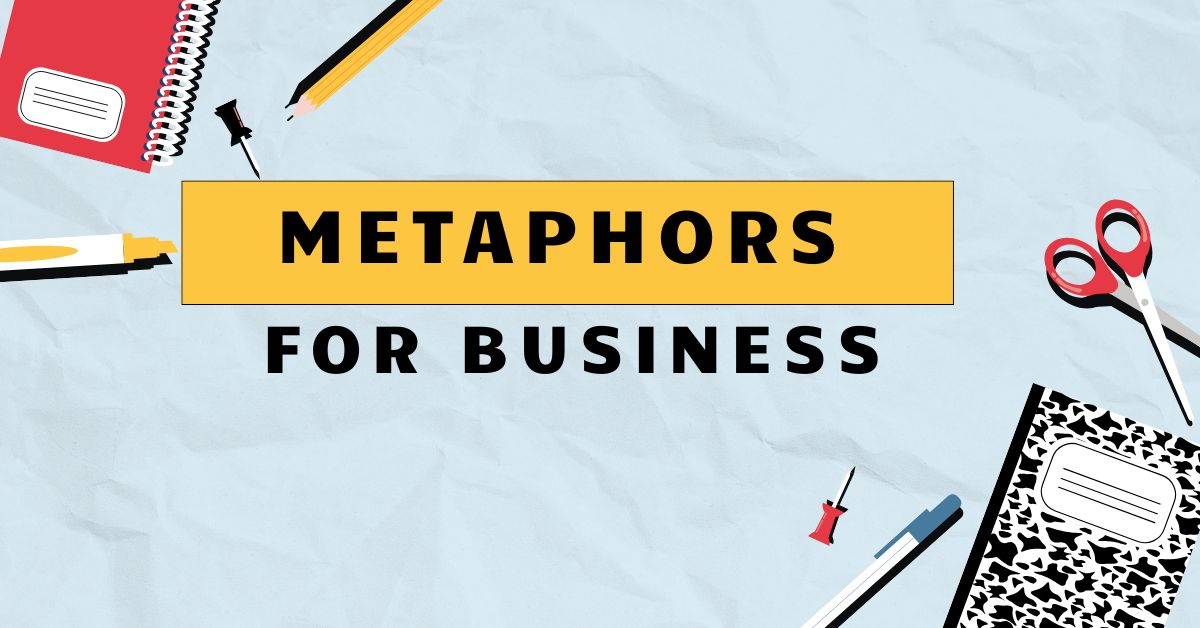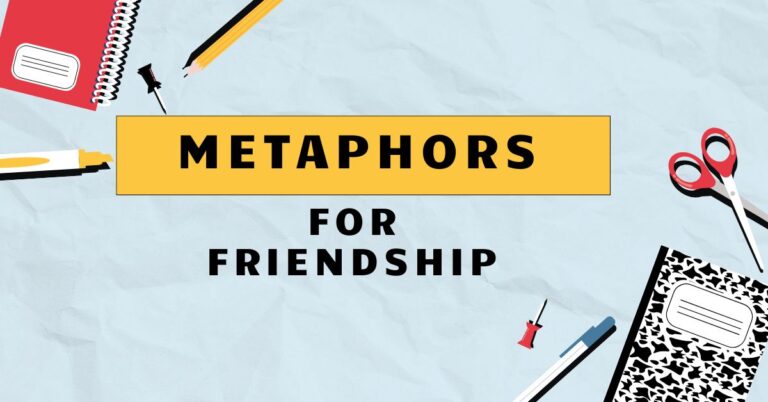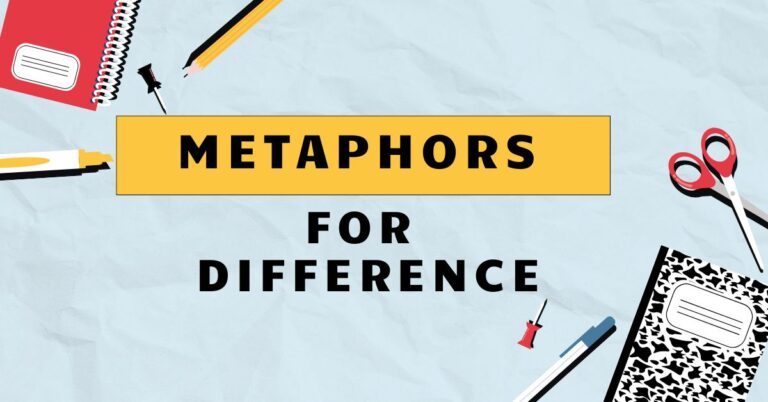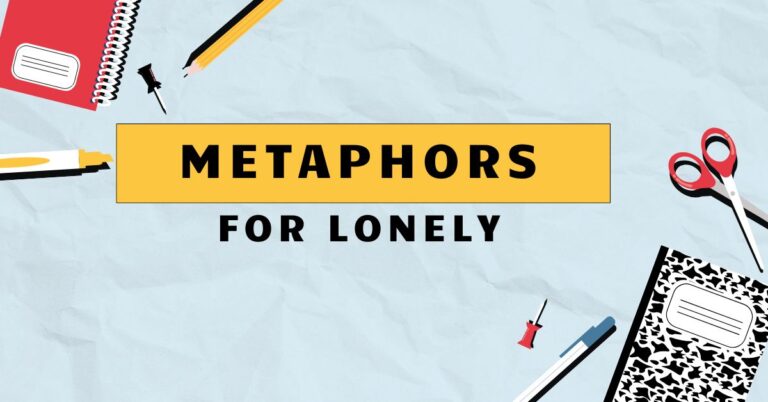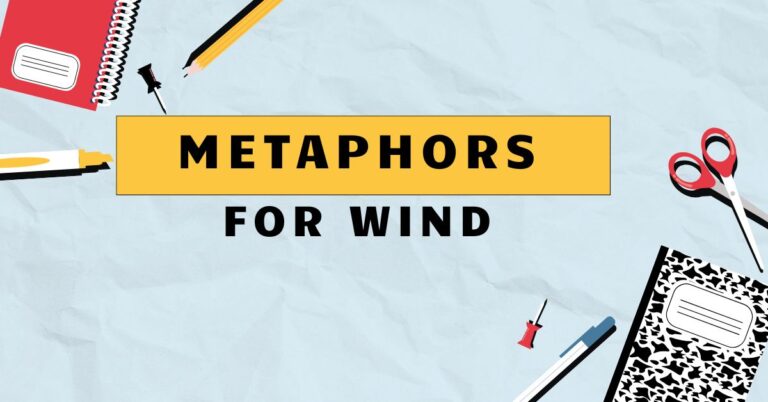49 Business Metaphors: Boost Communication & Understanding
Metaphors are powerful tools in communication, and in the business world, they can be particularly effective. Understanding and using metaphors can help you explain complex concepts, motivate your team, and create a more engaging and memorable message.
This article explores the use of metaphors in business, providing definitions, examples, and practical guidance on how to leverage them for better communication and strategic thinking. Whether you’re a seasoned executive or just starting your career, mastering the art of business metaphors can significantly enhance your communication skills and leadership abilities.
This guide will benefit anyone looking to improve their communication skills in a business context, including managers, marketers, sales professionals, and entrepreneurs.
This article will delve into the structural components of metaphors, explore diverse categories with detailed examples, and offer practical exercises to refine your grasp on their usage. We’ll also address common errors and provide advanced insights for those seeking a deeper understanding.
By the end of this guide, you’ll be well-equipped to strategically employ metaphors in your business interactions, fostering clarity, creativity, and enhanced engagement.
Table of Contents
- Introduction
- Definition of Metaphor
- Structural Breakdown
- Types and Categories of Business Metaphors
- Examples of Business Metaphors
- War Metaphor Examples
- Sports Metaphor Examples
- Journey Metaphor Examples
- Machine Metaphor Examples
- Organic Metaphor Examples
- Usage Rules for Business Metaphors
- Clarity and Relevance
- Audience Awareness
- Consistency and Avoidance of Mixed Metaphors
- Avoiding Overuse of Metaphors
- Common Mistakes with Business Metaphors
- Practice Exercises
- Exercise 1: Identifying Metaphors
- Exercise 2: Creating Metaphors
- Exercise 3: Correcting Mixed Metaphors
- Advanced Topics
- FAQ: Frequently Asked Questions
- Conclusion
Definition of Metaphor
What is a Metaphor?
A metaphor is a figure of speech that directly compares two unrelated things, asserting that one thingisanother. Unlike similes, which use “like” or “as” to make a comparison, metaphors make a direct equation.
This comparison is not literally true but is used for rhetorical effect, making a description more vivid or easier to understand. The power of a metaphor lies in its ability to transfer qualities or characteristics from one concept to another, creating a new understanding of the original subject.
For example, saying “time is money” doesn’t mean you can literally exchange time for currency, but it emphasizes the value and limited nature of time.
Metaphor vs. Simile
The key difference between a metaphor and a simile is the way the comparison is made. Asimileuses words like “like” or “as” to draw a comparison, highlighting the similarities between two things in a more explicit way.
For instance, “He is as brave as a lion” is a simile because it explicitly states the comparison using “as.” In contrast, ametaphordirectly equates the two things without using these words, implying a deeper connection or shared characteristic. For example, “He is a lion in battle” is a metaphor, directly stating his bravery by associating him with a lion.
Similes are often seen as less forceful and more descriptive, while metaphors are considered more impactful and transformative.
Consider the following table that highlights the key differences between Metaphors and Similes:
| Feature | Metaphor | Simile |
|---|---|---|
| Comparison | Direct: A is B | Indirect: A is like B, A is as B as C |
| Connecting Words | None | “Like,” “as,” “so” |
| Impact | Stronger, more assertive | Softer, more descriptive |
| Example | The entrepreneur is a shark. | The entrepreneur is as cunning as a fox. |
Function of Metaphors
Metaphors serve several important functions in communication. First, they simplify complex ideas by relating them to something more familiar.
This can be particularly useful in business when explaining abstract concepts or strategies. Second, metaphors can make communication more engaging and memorable, capturing the audience’s attention and helping them retain information.
Third, metaphors can be persuasive, influencing attitudes and behaviors by framing ideas in a particular light. Finally, metaphors can foster creativity and innovation by encouraging people to think about problems and solutions in new and different ways.
In essence, metaphors are not just decorative; they are essential tools for effective communication and strategic thinking.
Context of Use
The effectiveness of a metaphor depends heavily on the context in which it is used. Consider the audience, the message, and the overall communication goal.
In a formal business setting, more restrained and professional metaphors may be appropriate, while in a creative brainstorming session, more imaginative and unconventional metaphors might be encouraged. It’s also important to be aware of cultural differences, as some metaphors may not translate well or may have different connotations in different cultures.
Understanding the context allows you to choose metaphors that resonate with your audience and effectively convey your message.
Structural Breakdown
Tenor and Vehicle
The structure of a metaphor can be broken down into two key components: thetenorand thevehicle. Thetenoris the subject or concept that is being described.
It’s the underlying idea you want to convey. Thevehicleis the object or concept that is used to represent the tenor.
It’s the means by which you’re drawing the comparison. For example, in the metaphor “The project is a rollercoaster,” the tenor is the “project,” and the vehicle is “rollercoaster.” The rollercoaster is used to convey the idea that the project is full of ups and downs, excitement, and potential danger.
Ground of the Metaphor
Thegroundof a metaphor refers to the shared characteristics or similarities between the tenor and the vehicle. It’s the basis upon which the comparison is made.
In the example “The project is a rollercoaster,” the ground includes the shared characteristics of unpredictability, excitement, and potential for both highs and lows. Identifying the ground is crucial for understanding why a particular vehicle was chosen to represent the tenor and for ensuring that the metaphor effectively conveys the intended meaning.
The ground provides the logical connection that makes the metaphor resonate with the audience.
Implied Metaphors
An implied metaphor is a more subtle type of metaphor where the vehicle is not explicitly stated, but rather suggested or implied through descriptive language. Instead of saying “He is a shark,” an implied metaphor might say “He circled the deal aggressively, snapping up every opportunity.” Here, the shark is not directly mentioned, but the imagery associated with a shark is used to describe his behavior.
Implied metaphors can be more engaging and require the audience to actively participate in making the connection, but they also run the risk of being misunderstood if the connection is not clear enough. They add a layer of sophistication to communication and can be particularly effective in creative writing and persuasive speaking.
Types and Categories of Business Metaphors
War Metaphors
War metaphors are commonly used in business to describe competitive situations, aggressive strategies, and the pursuit of market dominance. These metaphors often invoke a sense of conflict, strategy, and the need for decisive action.
Examples include “attacking the market,” “battling competitors,” and “winning the war for talent.” While war metaphors can be motivating and energizing, they can also create a sense of aggression and hostility, so it’s important to use them judiciously and be mindful of their potential impact on team morale and company culture.
Using war metaphors can be highly effective in conveying a sense of urgency and the need for strategic planning. However, it is important to balance their use with more collaborative and cooperative language to avoid creating an overly combative atmosphere.
The key is to use them strategically to emphasize the importance of competition while maintaining a focus on ethical and sustainable business practices.
Sports Metaphors
Sports metaphors are widely used in business to emphasize teamwork, competition, and the pursuit of excellence. These metaphors often focus on collaboration, strategy, and the importance of practice and preparation.
Examples include “playing as a team,” “hitting a home run,” and “raising the bar.” Sports metaphors can be particularly effective in motivating teams and fostering a sense of camaraderie and shared purpose. They also provide a common language for discussing performance, strategy, and the importance of continuous improvement.
The universal appeal and understanding of sports make these metaphors easily accessible and relatable. However, it’s important to choose sports metaphors that align with the company culture and values.
For example, a company that values collaboration might emphasize metaphors related to team sports like basketball or soccer, rather than individual sports like golf or tennis.
Journey Metaphors
Journey metaphors are used to describe the progress, challenges, and goals of a project, career, or business venture. These metaphors often emphasize the importance of planning, perseverance, and adaptability.
Examples include “embarking on a new venture,” “navigating challenges,” and “reaching milestones.” Journey metaphors can be particularly effective in providing a sense of direction and purpose, helping people understand where they are going and how they will get there. They also highlight the importance of learning from setbacks and adapting to changing circumstances.
Journey metaphors can be particularly powerful in long-term projects or strategic initiatives, providing a framework for understanding the overall process and celebrating progress along the way. They also allow for the incorporation of milestones and checkpoints, providing opportunities to reflect on achievements and adjust strategies as needed.
The use of journey metaphors can create a sense of shared experience and collective progress towards a common goal.
Machine Metaphors
Machine metaphors often describe processes, systems, and organizations in terms of their efficiency, precision, and reliability. These metaphors highlight the importance of optimization, standardization, and predictability.
Examples include “a well-oiled machine,” “fine-tuning the process,” and “gearing up for success.” Machine metaphors can be useful for emphasizing the importance of operational efficiency and the need for continuous improvement. They can also be used to describe the interconnectedness of different parts of an organization or system.
While machine metaphors can be effective in emphasizing efficiency and reliability, it’s important to avoid dehumanizing the workforce or creating a culture that prioritizes process over people. The key is to use them in conjunction with other types of metaphors that emphasize collaboration, creativity, and human connection.
Organic Metaphors
Organic metaphors are used to describe growth, development, and the interconnectedness of different parts of a business or ecosystem. These metaphors often emphasize the importance of nurturing, adaptation, and sustainability.
Examples include “growing the business,” “cultivating relationships,” and “planting the seeds of success.” Organic metaphors can be particularly effective in emphasizing the long-term nature of business success and the importance of building strong relationships with customers, employees, and partners.
Organic metaphors also highlight the importance of adaptability and resilience in the face of change. Just as a plant must adapt to its environment in order to thrive, so too must a business adapt to changing market conditions and customer needs.
The use of organic metaphors can foster a culture of continuous learning, growth, and sustainability.
Examples of Business Metaphors
The following tables provide examples of common business metaphors, categorized by type. Each table includes examples of how the metaphor is used, the context in which it might be used, and the intended effect on the audience.
These examples are designed to help you understand how metaphors can be used effectively in different business situations.
War Metaphor Examples
War metaphors are often used to portray business situations as battles to be won through strategy and determination. They can create a sense of urgency and competition.
| Metaphor | Example Usage | Context | Intended Effect |
|---|---|---|---|
| Attack the market | “We need to attack the market with our new product.” | Launching a new product or service | To create a sense of aggressive marketing and sales efforts. |
| Battle competitors | “We are battling competitors for market share.” | Facing strong competition | To emphasize the competitive nature of the industry. |
| Win the war for talent | “We must win the war for talent to attract top employees.” | Recruiting and retaining employees | To highlight the importance of attracting and retaining skilled workers. |
| Strategic strike | “Our marketing campaign was a strategic strike against the competition.” | Marketing campaign | Emphasize a well-planned and effective marketing effort. |
| Take no prisoners | “In this negotiation, we take no prisoners.” | Negotiation | Indicate a hard-line stance and determination to succeed. |
| On the front lines | “Our sales team is on the front lines, dealing with customers daily.” | Sales operations | Highlight the direct contact and crucial role of the sales team. |
| Fortify our defenses | “We need to fortify our defenses against new market entrants.” | Market strategy | Emphasize the need to protect market position. |
| Casualties of war | “There will be casualties of war in this restructuring.” | Restructuring | Acknowledge potential job losses or negative impacts. |
| Arm ourselves with data | “We must arm ourselves with data to make informed decisions.” | Decision-making | Emphasize the importance of data-driven insights. |
| Amassing resources | “We are amassing resources for the upcoming campaign.” | Campaign preparation | Highlight the investment being made in the campaign. |
| Ground war | “The real challenge will be the ground war of implementation.” | Implementation phase | Emphasize the practical and detailed work required. |
| Air strikes | “Our initial marketing efforts will be air strikes to gain attention.” | Initial marketing efforts | Highlight the quick, impactful nature of the marketing. |
| Behind enemy lines | “Our team is working behind enemy lines, gathering competitive intelligence.” | Competitive intelligence | Emphasize the stealth and risk involved. |
| Fighting an uphill battle | “We are fighting an uphill battle against established brands.” | Market entry | Acknowledge the difficulty of competing with established players. |
| In the trenches | “Our engineers are in the trenches, fixing the bugs.” | Problem-solving | Highlight the hard work and dedication required. |
| Deploy resources | “We need to deploy resources strategically.” | Resource allocation | Emphasize careful and purposeful resource use. |
| Call in reinforcements | “We may need to call in reinforcements to meet the deadline.” | Project management | Indicate the need for additional support. |
| Winning the battle | “We are winning the battle for customer loyalty.” | Customer retention | Emphasize success in customer retention efforts. |
| Losing ground | “We are losing ground in the Asian market.” | Market performance | Indicate a decline in market share or performance. |
| Taking strategic ground | “We are taking strategic ground by partnering with key suppliers.” | Strategic partnerships | Highlight the importance of the partnerships. |
| Holding the line | “We need to hold the line on pricing to maintain profitability.” | Pricing strategy | Emphasize the need to stick to the current pricing. |
| Under siege | “Our customer service department is under siege due to the product recall.” | Customer service | Highlight the high volume of complaints and issues. |
| War room | “Let’s gather in the war room to discuss the crisis.” | Crisis management | Emphasize the seriousness and urgency of the situation. |
| Damage control | “We need to initiate damage control after the PR blunder.” | Public relations | Highlight the need to mitigate negative publicity. |
| Fighting fire | “We are constantly fighting fire instead of focusing on long-term goals.” | Management style | Emphasize the reactive nature of the management. |
Sports Metaphor Examples
Sports metaphors emphasize teamwork, competition, and achieving goals through coordinated effort and skill. They are great for motivating teams and highlighting the importance of strategy.
| Metaphor | Example Usage | Context | Intended Effect |
|---|---|---|---|
| Play as a team | “We need to play as a team to achieve our goals.” | Teamwork | To encourage collaboration and cooperation. |
| Hit a home run | “This new product is going to hit a home run.” | Product launch | To express confidence in the success of the product. |
| Raise the bar | “We need to raise the bar for our performance.” | Performance improvement | To challenge the team to achieve higher standards. |
| Game plan | “Let’s finalize our game plan for the next quarter.” | Strategic planning | Emphasize the need for a well-thought-out strategy. |
| Knock it out of the park | “If we work hard, we can knock this project out of the park.” | Project execution | Encourage exceptional performance and success. |
| Ahead of the game | “We are ahead of the game in terms of innovation.” | Innovation | Highlight leading position in the market. |
| Ball is in your court | “The ball is in your court to make the next move.” | Decision-making | Emphasize responsibility for the next step. |
| Benchmarking | “We are benchmarking our performance against the industry leaders.” | Performance analysis | Highlight the process of measuring against best practices. |
| Changing the playing field | “Our new technology is changing the playing field.” | Technological advancement | Emphasize the disruptive nature of the technology. |
| Cover all the bases | “We need to cover all the bases before launching the campaign.” | Campaign preparation | Ensure thoroughness and preparedness. |
| Deep dive | “Let’s do a deep dive into the data to find insights.” | Data analysis | Emphasize the need for thorough investigation. |
| End game | “What’s our end game for this project?” | Project planning | Focus on the ultimate goal or outcome. |
| Fast track | “We need to fast track this project to meet the deadline.” | Project management | Emphasize the need for expedited completion. |
| Get the ball rolling | “Let’s get the ball rolling on this initiative.” | Initiative launch | Encourage starting the initiative promptly. |
| Huddle up | “Let’s huddle up to discuss the strategy.” | Team meeting | Emphasize teamwork and collaboration. |
| Jump the gun | “We don’t want to jump the gun and launch before we’re ready.” | Launch timing | Caution against premature action. |
| Keep our eye on the ball | “We need to keep our eye on the ball to stay focused.” | Focus maintenance | Emphasize the need to stay focused on the goal. |
| Level playing field | “We need a level playing field to compete fairly.” | Market conditions | Emphasize the need for fair competition. |
| Move the goalposts | “They keep moving the goalposts, making it hard to succeed.” | Changing requirements | Highlight the frustration of shifting targets. |
| Neck and neck | “We are neck and neck with our competitor in market share.” | Competitive analysis | Emphasize the close competition. |
| On the sidelines | “We can’t afford to stay on the sidelines; we need to be active.” | Active participation | Emphasize the need to participate actively. |
| Play hardball | “We may need to play hardball in these negotiations.” | Negotiation tactics | Emphasize the need for aggressive tactics. |
| Quick win | “Let’s focus on quick wins to build momentum.” | Strategic priorities | Emphasize the importance of early successes. |
| Run with it | “If you have a good idea, run with it.” | Idea execution | Encourage initiative and follow-through. |
| Step up to the plate | “It’s time for everyone to step up to the plate and contribute.” | Contribution expectation | Encourage everyone to do their part. |
Journey Metaphor Examples
Journey metaphors are useful for describing long-term projects, career paths, or business development, highlighting progress, challenges, and the need for adaptability.
| Metaphor | Example Usage | Context | Intended Effect |
|---|---|---|---|
| Embarking on a new venture | “We are embarking on a new venture in the Asian market.” | Business expansion | To create excitement and anticipation. |
| Navigating challenges | “We are navigating challenges in the regulatory environment.” | Problem-solving | To acknowledge difficulties and the need for problem-solving. |
| Reaching milestones | “We are reaching milestones in our product development.” | Project progress | To celebrate progress and acknowledge achievements. |
| Roadmap | “Let’s create a roadmap for the next five years.” | Strategic planning | Emphasize the need for a clear plan. |
| Smooth sailing | “After the initial challenges, it’s been smooth sailing.” | Project status | Indicate a period of easy progress. |
| Charting a course | “We are charting a course for future growth.” | Strategic direction | Emphasize the proactive planning. |
| Crossroads | “We are at a crossroads and need to decide our next steps.” | Decision point | Highlight the significance of the decision. |
| Destination | “Our destination is to be the market leader.” | Strategic goal | Emphasize the ultimate objective. |
| Expedition | “This project is an expedition into uncharted territory.” | Innovative project | Highlight the exploratory nature. |
| Following the path | “We are following the path laid out by our predecessors.” | Continuity | Emphasize the importance of legacy. |
| Gaining ground | “We are gaining ground in customer satisfaction.” | Improvement | Highlight progress in a specific area. |
| Hurdles | “We need to overcome several hurdles to launch the product.” | Challenges | Acknowledge the obstacles. |
| Itinerary | “Let’s finalize the itinerary for the conference.” | Event planning | Emphasize the need for a detailed plan. |
| Journey | “The journey to success is long and challenging.” | General progress | Highlight the persistence required. |
| Keeping on track | “We need to keep on track to meet our goals.” | Progress maintenance | Emphasize the need to stay focused. |
| Landmark | “This acquisition is a landmark achievement for our company.” | Achievement | Highlight the significance of the event. |
| Moving forward | “We are moving forward with our plans despite the challenges.” | Progress | Emphasize continued progress. |
| New horizon | “We are exploring new horizons in renewable energy.” | New opportunities | Highlight new areas for exploration. |
| On the right track | “We are on the right track with our new strategy.” | Positive progress | Emphasize that the strategy is working. |
| Paving the way | “We are paving the way for future innovation.” | Future impact | Emphasize the long-term benefits. |
| Quest | “Our quest is to find the best talent in the industry.” | Search effort | Emphasize the dedication to finding the best. |
| Roadblock | “We encountered a roadblock in our negotiations.” | Unexpected obstacle | Acknowledge the obstacle. |
| Setting sail | “We are setting sail on a new chapter for our company.” | New beginning | Highlight the start of something new. |
| Trailblazing | “We are trailblazing in the field of artificial intelligence.” | Innovation leadership | Emphasize the pioneering efforts. |
| Uncharted waters | “We are venturing into uncharted waters with this new project.” | Unknown territory | Acknowledge the uncertainty. |
Machine Metaphor Examples
Machine metaphors are frequently used to describe organizational efficiency, processes, and systems, emphasizing standardization and predictability.
| Metaphor | Example Usage | Context | Intended Effect |
|---|---|---|---|
| A well-oiled machine | “Our department is a well-oiled machine.” | Operational efficiency | To highlight the smooth and efficient functioning of the department. |
| Fine-tuning the process | “We are fine-tuning the process to improve efficiency.” | Process optimization | To emphasize the ongoing efforts to improve performance. |
| Gearing up for success | “We are gearing up for success with this new product launch.” | Preparation | To create a sense of anticipation and readiness. |
| Assembly line | “Our production process is like an assembly line.” | Production process | Emphasize the efficiency and standardization. |
| Cogs in a machine | “Each employee is a cog in the machine that drives our company.” | Employee roles | Highlight the importance of each role. |
| Bandwidth | “Do you have the bandwidth to take on this new project?” | Capacity | Inquire about available resources. |
| Clockwork | “Our operations run like clockwork.” | Reliability | Emphasize dependability. |
| Diagnostics | “We need to run diagnostics on our system.” | System assessment | Highlight the need to evaluate performance. |
| Engine | “Our sales team is the engine that drives our revenue.” | Critical function | Emphasize the importance of the sales team. |
| Framework | “We need a solid framework for our project.” | Structure | Highlight the need for a foundation. |
| Gears | “The gears are turning to get this project moving.” | Action | Emphasize the progress. |
| Hardware | “Our IT infrastructure is the hardware of our business.” | Infrastructure | Highlight the importance of the IT system. |
| Interface | “The user interface needs to be more intuitive.” | Usability | Emphasize the need for ease of use. |
| Jumpstart | “We need to jumpstart this project to meet the deadline.” | Acceleration | Highlight the need to accelerate progress. |
| Key component | “Our marketing strategy is a key component of our success.” | Critical element | Emphasize the importance of the strategy. |
| Leverage | “We need to leverage our resources to achieve our goals.” | Resource utilization | Highlight the need to use resources effectively. |
| Mechanism | “Our pricing mechanism needs to be adjusted.” | System | Emphasize the need to adjust the pricing system. |
| Network | “Our network of partners is critical to our success.” | Partnerships | Highlight the importance of the partnerships. |
| Optimize | “We need to optimize our processes to reduce costs.” | Improvement | Emphasize the need for efficiency. |
| Powerhouse | “Our R&D department is a powerhouse of innovation.” | Strength | Highlight the strength of the department. |
| Quick fix | “We need a quick fix to address this issue.” | Immediate solution | Emphasize the need for a fast solution. |
| Robust | “Our system needs to be more robust to handle the load.” | Durability | Emphasize the need for a strong system. |
| Streamline | “We need to streamline our operations to improve efficiency.” | Efficiency | Emphasize the need for efficiency. |
| Tune-up | “We need to give our marketing strategy a tune-up.” | Improvement | Emphasize the need to improve the strategy. |
| Upgrade | “We need to upgrade our systems to stay competitive.” | Modernization | Emphasize the need to modernize the systems. |
Organic Metaphor Examples
Organic metaphors emphasize growth, development, and the interconnectedness of business elements, focusing on nurturing and sustainability.
| Metaphor | Example Usage | Context | Intended Effect |
|---|---|---|---|
| Growing the business | “We are focused on growing the business in new markets.” | Business expansion | To highlight the company’s expansion efforts. |
| Cultivating relationships | “We need to cultivate relationships with our key clients.” | Client management | To emphasize the importance of strong client relationships. |
| Planting the seeds of success | “We are planting the seeds of success with our new initiatives.” | New projects | To create optimism about future success. |
| Branching out | “We are branching out into new product lines.” | Product diversification | Emphasize the company’s expansion. |
| Ecosystem | “Our business operates within a complex ecosystem.” | Business environment | Highlight the interconnectedness of the business environment. |
| Bloom | “We expect our business to bloom in the coming years.” | Growth anticipation | Express optimism about future growth. |
| Climate | “The current economic climate is challenging.” | Economic conditions | Acknowledge the impact of the economy. |
| Deep roots | “Our company has deep roots in the community.” | Long-standing presence | Emphasize the company’s history. |
| Fertile ground | “The Asian market is fertile ground for our products.” | Market potential | Highlight the potential of the market. |
| Germinate | “We need to allow our ideas to germinate.” | Idea development | Emphasize the need for time to develop ideas. |
| Harvest | “We are ready to harvest the benefits of our hard work.” | Benefit realization | Emphasize the upcoming rewards. |
| Incubate | “We are incubating new ventures within our company.” | Venture development | Highlight the internal innovation. |
| Juicy | “This deal is a juicy opportunity for our company.” | Attractive opportunity | Emphasize the attractiveness of the deal. |
| Keystone | “Customer satisfaction is the keystone of our business.” | Essential element | Emphasize the importance of customer satisfaction. |
| Landscape | “The competitive landscape is constantly changing.” | Market environment | Highlight the dynamic nature of the market. |
| Nurture | “We need to nurture our employees to help them grow.” | Employee development | Emphasize the importance of employee growth. |
| Organic growth | “We are focused on organic growth rather than acquisitions.” | Natural expansion | Highlight the focus on internal growth. |
| Pollinate | “We need to pollinate ideas across departments.” | Idea sharing | Emphasize the importance of sharing ideas. |
| Quench | “We need to quench the market’s thirst for our product.” | Market demand | Emphasize the need to meet the market demand. |
| Rooted | “Our values are rooted in integrity and customer service.” | Core values | Emphasize the company’s core values. |
| Sustainable | “We need to create a sustainable business model.” | Long-term viability | Emphasize the need for a viable model. |
| Thrive | “We want our employees to thrive in our company.” | Employee success | Emphasize the goal of employee success. |
| Unearth | “We need to unearth new opportunities in the market.” | Opportunity search | Emphasize the need to find new opportunities. |
| Vital | “Innovation is vital to our company’s success.” | Essential element | Emphasize the importance of innovation. |
Usage Rules for Business Metaphors
Using metaphors effectively in business requires careful consideration of several factors. Clarity, relevance, audience awareness, consistency, and avoiding overuse are all crucial for successful communication.
The following guidelines will help you use metaphors in a way that enhances understanding and engagement.
Clarity and Relevance
The most important rule for using metaphors is to ensure they are clear and relevant to your audience. A metaphor should simplify rather than confuse the message.
The connection between the tenor and the vehicle should be easily understood, and the metaphor should directly relate to the topic being discussed. If the audience struggles to understand the metaphor, it loses its effectiveness and can even detract from the message.
To ensure clarity and relevance, consider the following:
- Choose familiar vehicles: Use concepts that are well-known and easily understood by your audience.
- Establish clear connections: Make sure the similarities between the tenor and the vehicle are obvious.
- Avoid obscure references: Steer clear of metaphors that rely on specialized knowledge or cultural references that may not be universally understood.
Audience Awareness
Understanding your audience is essential when using metaphors. Different audiences may interpret metaphors differently based on their background, culture, and experience.
A metaphor that resonates with one group may be confusing or even offensive to another. Tailor your metaphors to suit the specific audience you are addressing.
Consider the following when choosing metaphors for different audiences:
- Cultural sensitivity: Be aware of cultural differences and avoid metaphors that may be offensive or misunderstood in certain cultures.
- Professional background: Use metaphors that align with the audience’s professional experience and knowledge.
- Level of understanding: Adjust the complexity of your metaphors based on the audience’s level of understanding of the topic.
Consistency and Avoidance of Mixed Metaphors
Consistency is key when using metaphors. Once you establish a metaphor, maintain it throughout your communication.
Avoid shifting to unrelated metaphors mid-sentence or mid-presentation, as this can create confusion and undermine your message. Mixed metaphors, where two or more incompatible metaphors are combined, are a common mistake that can make your communication sound nonsensical.
To maintain consistency and avoid mixed metaphors:
- Stick to a single theme: Choose a central metaphor and use variations of it throughout your communication.
- Review your language: Carefully review your writing and speaking to identify and eliminate any mixed metaphors.
- Seek feedback: Ask colleagues or friends to review your communication and point out any inconsistencies or mixed metaphors.
Avoiding Overuse of Metaphors
While metaphors can be powerful, overuse can diminish their impact. Too many metaphors can make your communication sound contrived and overwhelming.
Use metaphors strategically to highlight key points or simplify complex ideas, but avoid peppering your communication with them unnecessarily. A well-placed metaphor can be more effective than a barrage of them.
To avoid overuse of metaphors:
- Use them sparingly: Reserve metaphors for moments when they can have the greatest impact.
- Balance with literal language: Mix metaphors with clear, direct language to maintain clarity and avoid sounding overly poetic.
- Vary your communication style: Use a mix of rhetorical devices, not just metaphors, to keep your communication engaging and dynamic.
Common Mistakes with Business Metaphors
Even with a good understanding of metaphors, it’s easy to make mistakes in their usage. Common pitfalls include creating mixed metaphors, using unclear metaphors, and employing inappropriate metaphors.
Recognizing these mistakes is the first step in avoiding them and using metaphors effectively.
Mixed Metaphors
A mixed metaphor combines two or more incompatible metaphors, creating a nonsensical or confusing image. This often happens when the speaker or writer loses track of the original metaphor and introduces another that clashes with it.
Mixed metaphors can undermine the credibility of the speaker and confuse the audience.
Example of a Mixed Metaphor: “We need to nip it in the bud before it snowballs out of control and runs us into the ground.”
Explanation: This sentence mixes three metaphors: “nip it in the bud” (stopping something early), “snowballs out of control” (growing rapidly), and “runs us into the ground” (destroying us). These metaphors don’t fit together logically, creating a confusing image.
Corrected Example: “We need to address this issue quickly before it escalates and causes significant problems.”
Unclear Metaphors
An unclear metaphor is one where the connection between the tenor and the vehicle is not easily understood. This can happen if the vehicle is too obscure, or if the shared characteristics between the tenor and the vehicle are not apparent.
Unclear metaphors can leave the audience confused and unsure of the intended meaning.
Example of an Unclear Metaphor: “Our strategy is a Byzantine labyrinth.”
Explanation: Unless the audience is familiar with the complexities of Byzantine history and architecture, they may not understand what the speaker is trying to convey. The metaphor lacks a clear connection that the audience can easily grasp.
Corrected Example: “Our strategy is complex and intricate, requiring careful navigation.”
Inappropriate Metaphors
An inappropriate metaphor is one that is unsuitable for the context or audience. This can happen if the metaphor is offensive, insensitive, or simply out of place in a professional setting.
Inappropriate metaphors can damage the speaker’s credibility and alienate the audience.
Example of an Inappropriate Metaphor: “This project is a real train wreck.”
Explanation: While this metaphor conveys the idea that the project is a disaster, it is overly negative and could be considered insensitive, especially if people have worked hard on the project. It’s also a bit of a cliché.
Corrected Example: “This project has faced significant challenges and requires immediate attention.”
Practice Exercises
To solidify your understanding of business metaphors, try the following exercises. These exercises will help you identify metaphors, create your own, and correct common mistakes.
Exercise 1: Identifying Metaphors
Read the following sentences and identify the metaphors used. Explain the tenor, vehicle, and ground of each metaphor.
- “Our sales team is the engine that drives our company’s growth.”
- “The market is a jungle, and we need to be strategic to survive.”
- “This project is a rollercoaster ride with many ups and downs.”
- “Our company’s culture is the glue that holds us together.”
- “Time is a thief, and we need to use it wisely.”
Answers:
-
Metaphor: “Our sales team is the engine that drives our company’s growth.”
Tenor: Sales team
Vehicle: Engine
Ground: The sales team provides the main driving force for the company’s growth, similar to how an engine powers a vehicle. -
Metaphor: “The market is a jungle, and we need to be strategic to survive.”
Tenor: Market
Vehicle: Jungle
Ground: The market is a competitive and dangerous environment where only the strong and strategic can survive, similar to a jungle. -
Metaphor: “This project is a rollercoaster ride with many ups and downs.”
Tenor: Project
Vehicle: Rollercoaster ride
Ground: The project has many unpredictable and exciting moments, both positive and negative, similar to a rollercoaster ride. -
Metaphor: “Our company’s culture is the glue that holds us together.”
Tenor: Company’s culture
Vehicle: Glue
Ground: The company’s culture provides the binding force that keeps the employees and the organization united, similar to how glue holds objects together. -
Metaphor: “Time is a thief, and we need to use it wisely.”
Tenor: Time
Vehicle: Thief
Ground: Time is something that can be easily lost or wasted if not managed carefully, similar to how a thief steals valuable possessions.
Exercise 2: Creating Metaphors
Create a metaphor for each of the following business concepts. Identify the tenor, vehicle, and ground of each metaphor.
- Innovation
- Leadership
- Customer service
- Teamwork
- Strategic planning
Sample Answers: (Answers may vary)
-
Concept: Innovation
Metaphor: “Innovation is the lifeblood of our company.”
Tenor: Innovation
Vehicle: Lifeblood
Ground: Innovation is essential for the company’s survival and growth, similar to how lifeblood is essential for the body’s survival. -
Concept: Leadership
Metaphor: “Leadership is the compass that guides our team.”
Tenor: Leadership
Vehicle: Compass
Ground: Leadership provides direction and guidance to the team, similar to how a compass provides direction to a traveler. -
Concept: Customer service
Metaphor: “Customer service is the bridge that connects us to our customers.”
Tenor: Customer service
Vehicle: Bridge
Ground: Customer service provides a connection and a way to communicate with customers, similar to how a bridge

